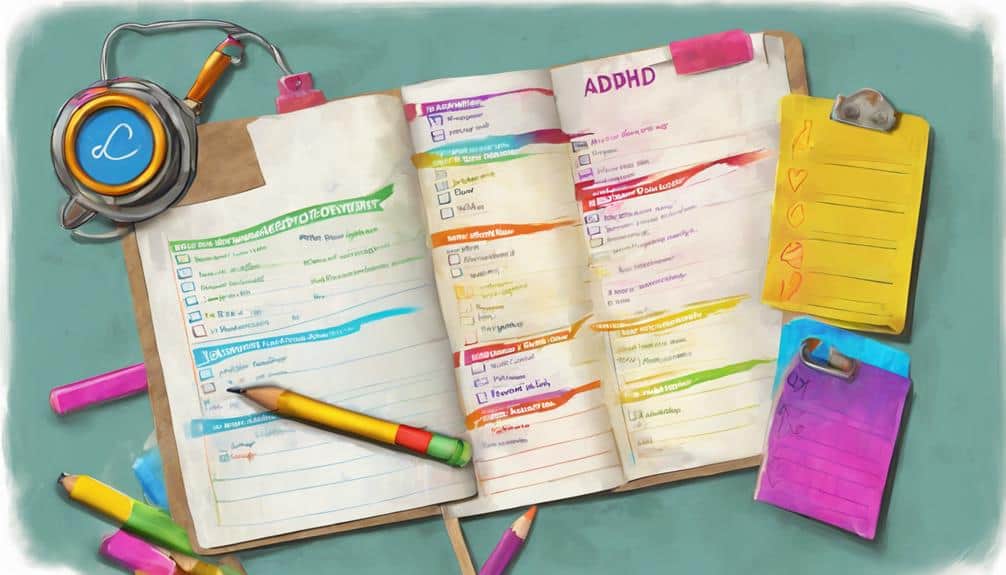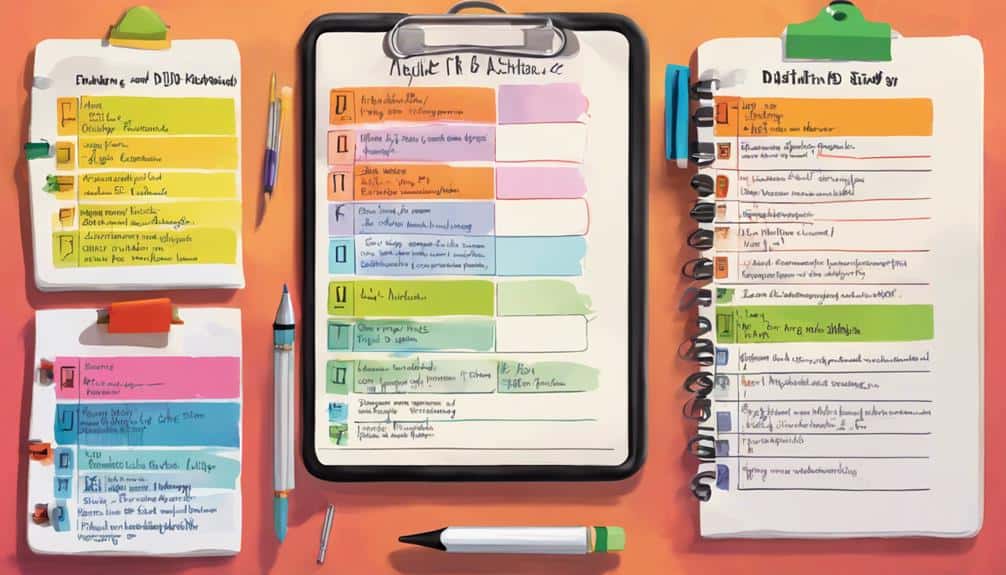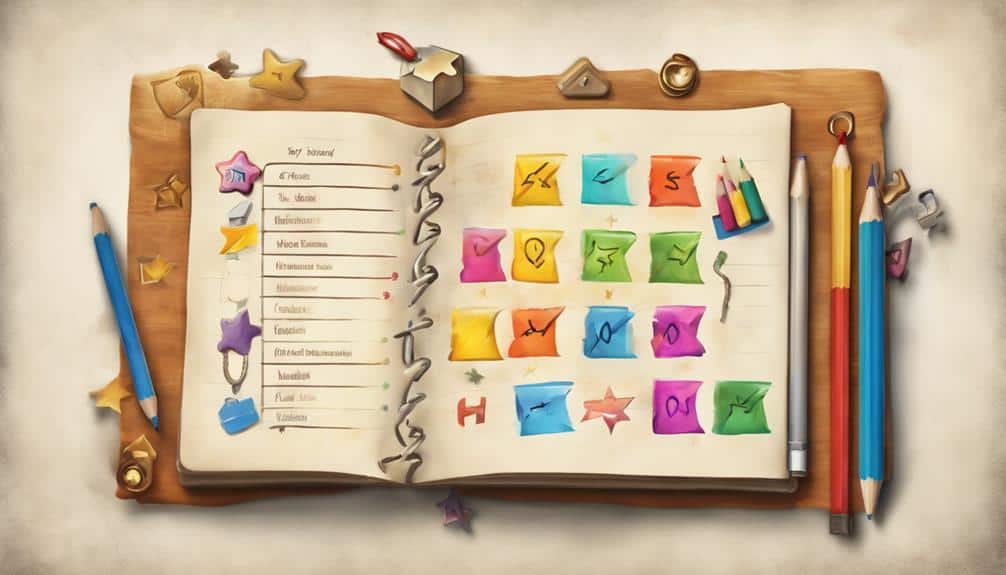Adhd Student Checklist
As someone who may have reservations about incorporating checklists into a student's routine, I understand the concern around adding another task to an already full schedule. However, the ADHD Student Checklist offers a streamlined approach to managing academic responsibilities and fostering independence. With its ability to enhance organization and focus, the checklist serves as a beneficial tool for students with ADHD.
By exploring the benefits, components, and implementation tips of this resource, you can discover a practical way to support academic success and skill development in students facing attention and executive functioning challenges.
Key Takeaways
- Enhances organization and focus for ADHD students.
- Breaks down tasks into manageable steps.
- Empowers learners to overcome challenges.
- Fosters structured task management for improved productivity.
Benefits of Using ADHD Student Checklist

Using an ADHD student checklist empowers learners to overcome challenges related to distraction and forgetfulness, fostering a structured approach to task management. These checklists serve as invaluable tools by enhancing organization and focus. They break down intimidating tasks into smaller, manageable steps, which is especially beneficial for individuals with ADHD who may struggle with staying on track. By providing a clear roadmap, ADHD student checklists reduce the likelihood of errors and promote task completion.
One of the key advantages of these checklists is their customizable nature. Tailoring the length and content of the checklist to individual needs guarantees that students can effectively manage their tasks. Whether it's a short list for daily assignments or a more detailed one for long-term projects, the flexibility of these checklists allows for personalized support. Additionally, the reusable aspect of these checklists, coupled with teaching and modeling, helps students develop essential self-monitoring skills that are critical for academic success.
Components of an Effective Checklist

Crafting an effective ADHD student checklist requires careful consideration of specific tasks broken down into manageable steps, engaging visual elements, and portability for versatile use. For students with ADHD, having clear and concise tasks is essential as it helps in avoiding overwhelm and confusion. Breaking down tasks into smaller steps makes them more essential and increases the likelihood of completion. Visual engagement through the use of colors, pictures, or symbols can enhance understanding and retention, making the checklist more appealing and easier to follow for students with ADHD.
Portability is another key component to take into account when creating an ADHD student checklist. The ability to carry the checklist to various environments such as home, school, or on-the-go ensures that it remains accessible and can be utilized whenever needed. Additionally, incorporating positive reinforcement or rewards for completing tasks on the checklist can motivate and encourage the student to stay engaged and focused. Regular review and updates based on the student's progress and changing needs are vital for maintaining the checklist's effectiveness over time.
Tips for Implementing the Checklist

To effectively implement the ADHD student checklist, make sure that specific tasks and expectations are clearly outlined to provide clarity for the student. Breaking down larger tasks into smaller, manageable steps can prevent overwhelm and promote task completion. This approach helps the student focus on one task at a time, making progress more achievable. Visual cues or symbols on the checklist can enhance understanding and engagement for the student, making it easier for them to follow along.
Encouraging the student to actively participate in creating or customizing their checklist can increase ownership and motivation. When individuals feel involved in the process, they're more likely to adhere to the checklist and take pride in their accomplishments. Additionally, regularly reviewing and updating the checklist based on the student's progress and feedback guarantees its effectiveness. This ongoing evaluation allows for adjustments to be made, tailoring the checklist to the student's evolving needs and optimizing its impact on task completion.
How to Customize the Checklist

When customizing the checklist for an ADHD student, it's critical to take into account their specific needs, preferences, and learning style to guarantee maximum effectiveness. Understanding the individual challenges and strengths of the student is key to tailoring the checklist for ADHD support. Here are some essential strategies for customizing the checklist:
- Consider Age and Grade Level: Adapting the checklist to suit the student's developmental stage and academic requirements can enhance its relevance and usability.
- Address Individual Challenges: Incorporating tasks that target the student's specific areas of difficulty can provide personalized support and encouragement.
- Provide Clear Instructions: Ensuring that each item on the checklist includes straightforward and concise directions can help the student navigate tasks more effectively.
Long-Term Impact of Checklist Compliance

Engaging with a checklist consistently can yield lasting benefits for students, shaping their academic performance and executive functioning skills over time. For individuals with attention deficit, maintaining checklist compliance can be a powerful tool in managing daily tasks and responsibilities. By adhering to a checklist, students with ADHD can make significant strides in enhancing their mental health and overall well-being.
In addition, consistent use of a checklist not only improves academic performance but also fosters the development of essential executive functioning skills. Students who actively engage with checklists often find themselves better equipped to navigate challenges related to organization, time management, and task completion. This enhanced skill set can have a profound impact on their long-term success in both educational and professional settings.
Furthermore, monitoring checklist compliance allows students to cultivate self-awareness, identifying patterns in their work habits and areas for improvement. By instilling a sense of responsibility and accountability, checklist adherence can help students establish lasting habits that contribute to their growth and development. Research indicates that students who make a commitment to checklist compliance are more likely to achieve positive long-term outcomes, highlighting the enduring benefits of this simple yet effective tool.
Frequently Asked Questions
Do Checklists Help Students With Adhd?
Yes, checklists greatly help students with ADHD. They enhance study strategies, time management, and organization skills. By breaking tasks into manageable steps, checklists provide structure and guidance to combat distraction and forgetfulness effectively.
What ADHD Students Need?
I need personalized study strategies, strong support systems, and effective time management to thrive. Understanding my unique needs and providing tailored assistance will empower me to excel academically despite challenges.
What Are the 9 Major Symptoms of Adhd?
I struggle with impulsivity, inattention, and hyperactivity daily. My distractibility causes forgetfulness, making tasks challenging. Restlessness is a constant battle. Understanding these symptoms helps manage ADHD's impact on my life, relationships, and work.
What Is the Task List for ADHD Children?
Staying organized and managing time effectively are essential for students with ADHD. Developing strong organization skills and study habits can make a big difference. It's important to have tools like checklists to help stay on track.
Conclusion
In the journey of academic success, the ADHD Student Checklist serves as a compass, guiding students through the maze of distractions and forgetfulness. Like a trusty map, this tool breaks down tasks into manageable steps, leading to improved organization and focus.
By embracing the checklist, students can navigate the challenges of ADHD with confidence, ultimately reaching their destination of improved productivity and task completion. Let the checklist be your guiding star in the sea of academic demands.







